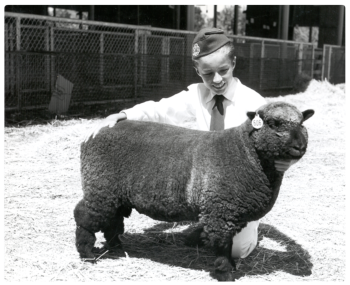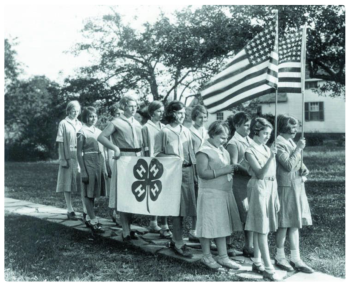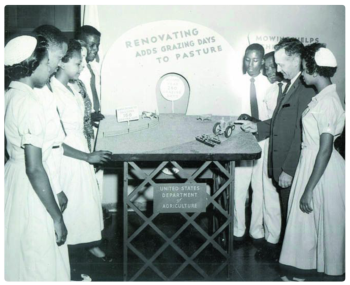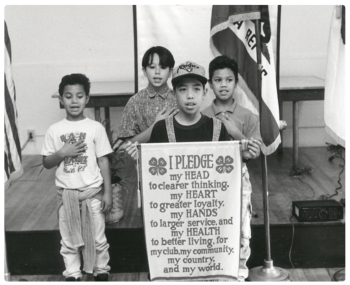4-H History

The 4-H program began around the start of the 20th century with the work of several people throughout the United States who were concerned about the positive growth of young people.
The seed of the 4-H idea of practical and "hands-on" learning came from the desire to make public school education more connected to country life. Early programs tied both public and private resources together for the purpose of helping rural youth.
During this time, researchers at experiment stations of the land-grant college system and USDA saw that adults in the farming community did not readily accept new agricultural discoveries. However, educators found that youth could "experiment" with these new ideas and then share their experiences and successes with the adults.
As a result, rural youth programs became a way to introduce new agricultural technology to adults. A.B. Graham started one such youth program in Ohio in 1902, considered the birth of the 4-H program in the U.S. When Congress created the Cooperative Extension Service in the USDA in 1914, it included boys' and girls' club work. These soon became known as 4-H clubs - head, heart, hands, and health.

In the 1950s, 4-H began to extend into urban areas as well. Soon, the focus of 4-H became centered around the personal growth of the member. Life skills development was built into 4-H projects, activities and events to help youth become contributing, productive, self-directed members of society. The organization changed in the 1960s, combining 4-H groups divided by gender or race into a single integrated program.
Read more about National 4-H History.
History of the 4-H Pledge
- Written by Otis Hall of the Kansas State College of Agriculture
- June 1927 - Officially adopted by the 4-H program at the first National 4-H Camp
- 1973 - At the request of several states and on the recommendation of 4-H members attending the National 4-H Conference, the pledge was changed in 1973 to include "my world." Their addition is the only change ever made to the 4-H pledge.
See the 4-H Pledge in multiple languages.
California 4-H History

As early as 1912, the University of California had encouraged the formation of boys' and girls' agricultural clubs in rural areas and collaborated with school districts to organize them. In 1913, the forerunner of 4-H was founded- an agricultural club at the college of agriculture in Davis. By 1914, eighty-four high school agricultural clubs were reported in California. The goal of these clubs was not only to train youth in agricultural skills, but to influence the practices of adult farmers and homemakers through their ongoing projects. University Extension staff outlined project work and ultimately concentrated the twenty-four original projects into six. Although girls were not specifically excluded, membership in the earliest clubs consisted only of boys.
Each club sponsored contests in animal or crop production, with members keeping detailed records and competing to make the largest profit. In 1915, thirty-seven clubs had at least six boys each and were competing against each other in local contests. By 1917, 2,716 participants in 208 high school agricultural clubs were engaged in projects under the direction of the University of California. Contest winners received prizes, usually a trip to Berkeley or the University Farm in Davis. In the summer of 1914, 142 boys enjoyed three days of camping in militia tents at the University Farm in Davis, establishing the start of the annual summer 4-H conference.
During the 1920s, agricultural club work continued to grow. More than 5,000 youth were enrolled by mid-decade, and more than 400 volunteer leaders contributed their time to club work. The ever popular club summer camps continued at the University Farm, bringing youth together from throughout California.
In 1928, the title "4-H" appeared in California reports of youth work. In the 1930s, over 10,000 youth in California 4-H clubs were developing skills through individual projects and learning leadership and civic responsibility through community improvement projects. As totalitarianism threatened Europe toward the end of the decade, 4-H leaders placed a new emphasis on citizenship training, the history of democracy, government processes, political parties, and voting.
In 1953, a state 4-H club leader was assigned by the University Extension. 4-H programs were reorganized with a widened project base aimed to reach a broader audience than just rural boys and girls. Projects were offered in rural electricity, tractor maintenance, entomology, and home economics. Projects were no longer required to show an economic return, and many 4-H clubs were used to extend research.
During the late 1960s, the traditional 4-H program received new stimulus. Congress appropriated funds for programs in low income urban areas and state funds were allocated for urban youth work. Some counties developed experimental 4-H programs, adopting projects and methods for new groups with special needs. In 1964, there were 37,000 4-H members in 1,000 clubs. By 1969, 4-H had grown to 50,000 members, with 20 percent of members coming from low income areas.
In the 1970s and 1980s, federal legislation focused on women, the handicapped, and minorities with respect to equal opportunity. The 4-H program attracted minorities with short-term projects, after-school programs, and special urban and migrant outreach efforts. Since not all programs effectively incorporated inner-city youth, 4-H specialists expanded the program by seeking grant funding and private support for special projects, such as the summer outdoor education project in the San Joaquin Valley.

During the 1980s, dramatic demographic and social changes spanning the dimensions of race, ethnicity, language, and socioeconomic positions arose in California. Many immigrants from Asia, Latin America, Russia, and the Caribbean settled in California. Family patterns that included single-parent households and working mothers had an impact on youth needs. As a result, 4-H fostered new ideas to revitalize existing programs and started new ones. In Los Angeles, 4-H pioneered programs in low-income housing projects such as drama, arts and crafts, cooking, math, and reading. Due to urban areas having large and heterogeneous populations, many urban programs were operated collaboratively with community organizations. In doing so, 4-H became a partner in federally funded programs that help children catch up in school, obtain health care, and adapt to new communities.
Today, after more than 100 years, 4-H offers opportunities in communications, leadership, career development, livestock, home improvement, and computer technology to 7 million American youth. Programs are found in rural and urban areas throughout the country and similar programs around the world. 4-H continues to grow and develop with the head, heart, hands, and health of our youth.
Collegiate 4-H History
In California, collegiate 4-H clubs were founded at UC Davis and UC Berkeley in 1932. Both clubs were inactive during WWII. UC Davis was re-activated in 1952, while the club at UC Berkeley remained inactive. here have been other collegiate 4-H clubs in California, including Cal Poly, San Luis Obispo, Stanford, Fresno State, and Humboldt State.
Nationally, collegiate 4-H clubs were formed as early as 1921. However, often they were not referred to as collegiate 4-H clubs. As an example, the North Carolina State University collegiate 4-H club began as the 4-H Supper Club. Growth of collegiate 4-H through the years has been demonstrated through a gradual movement toward objectives and goals as a collegiate 4-H "service oriented" organization. Founded in 1925 at Washington State College, Pullman, Mu Beta Beta 4-H Club Fraternity was established as a national 4-H honor fraternity to promote interest in college 4-H clubs. The motto was "Seek to Improve the Best." The fraternity is no longer active.




